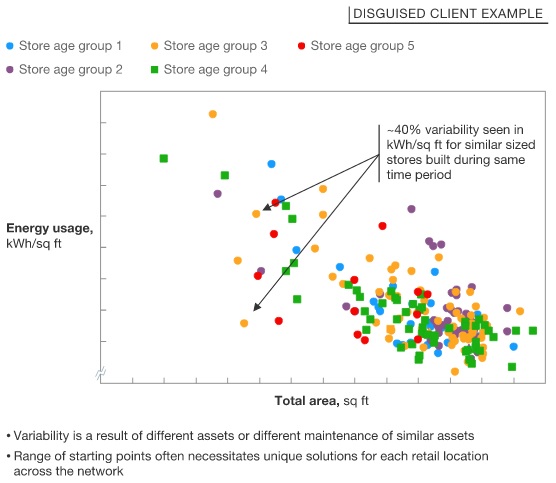Retail is one of the pillars of the American economy. The retail industry employs approximately 29 million people, representing 40% of the U.S. labor market. A significant number of retail operations are small businesses, from gas stations, convenience stores, motor vehicle dealers, and many others. Energy saving solutions for small businesses are typically straightforward, with LED lighting being the low-hanging fruit and most affordable option. For larger retail operations, such as wholesalers, supermarkets, and department stores, managing energy costs involves more than simply installing new LED lighting. Let’s examine some of the simple and advanced energy-savings strategies large retailers can do to help reduce annual energy costs.
Large Retail Energy Cost Management Opportunities
A 2015 report by McKinsey & Company concluded up to 50 percent in energy costs could be saved through energy efficiency. The report examined a variety of small and large retail operations and found stores with similar size, age, and type had differences up to 40 percent in how energy was consumed.
Source: McKinsey & Company: Turning down the cost of utilities in retail
Both stores are owned by the same company, were built around the same time, and are approximately the same square footage, yet one store’s energy costs are 40% higher than its sister store. It is possible that one store did not conduct routine facility energy audits. Energy technology changes every year, and new and improved solutions become available. Energy efficiency is never a one and done process.; it’s a continuous examination of energy consumption across all of a store’s operations. Energy audits should be completed once every few years to reevaluate new energy saving opportunities and to combat energy drift in mechanical operations. Let’s look at what energy cost solutions are available.
Energy Management Solutions
LED Lighting
LED lighting is the low-hanging fruit for all energy efficiency upgrades. Each year, LEDs become cheaper, more easily available, and provide exceptional energy savings compared to incandescents and fluorescents.
Lighting control strategies are also essential to ensure proper energy management. Typical control strategies include high end trim, daylight harvesting, demand response, zoning, dimming, and motion sensors. A 2015 study by the California Energy Research and Development Division found that maximizing adaptive lighting solutions, when compared with systems without adaptive lighting solutions, could save up to 60 percent on electricity costs in the retail sector.
Experts concur. According to Antony Corrie, president at Harvard Engineering:
“Lighting is the most underutilized tool in retail stores. Very few retail locations, if any, use lighting to its full potential. Lights can, and should, be able to be moved and controlled in terms of light level, scheduling profiles, and sensors.”
There are additional values to LED technology beyond energy savings. With the prevalence of online consumerism, a challenge for brick-and-motor retail operations is getting people to physically come into the store and make a purchase. According to Sally Lee, business development manager at Osram Sylvania in Danvers, MA, “Retail environments need to offer a superior shopping experience—one that’s interactive, interesting, and engaging. Good lighting design is critical to supporting that goal.”
HVAC
HVAC systems can account for up to 50% of a large retail operation’s energy consumption. There are three typical HVAC control strategies: demand control ventilation (DCV), economizers, and variable frequency drives (VFD).
- Demand control ventilation adjusts the amount of fresh air ventilated into a space, based on the number of occupants. The air will need to be conditioned at different levels during the slow and busy periods throughout the day. A DCV system adjusts the level at which the air is conditioned automatically, reducing energy consumption between 30-50% annually.
- Economizers detect both the inside and outside air temperatures and will turn off the HVAC compressor and utilize the outside air when necessary. Economizers can reduce energy consumption by up to 30% annually.
- Variable frequency drives vary the speed of a motor across the entire range of the motor’s RPM capacity. Without a VFD, a motor will run at the maximum speed it is designed for. For example, an 1,800 RPM motor will run at 1,800 RPMs for all operations, regardless of the actual RPMs needed to perform the function. VFDs can vary the speed of the motor to run only at the speed necessary for a particular function. Installing a VFD is an easy way to save up to 50% on all motor operations.
Will Teichman, director of sustainability at Kimco, says:
“Building controls and controlling your existing equipment in a better way is probably one of the most cost-effective ways to save energy. You’re not ripping out expensive equipment and putting in more expensive equipment in its place. You’re simply taking what exists in the building and controlling it more effectively.”
These energy efficiency solutions add another dimension to large retail energy cost management.
Energy Management System
An energy management system (EMS) is designed to produce holistic energy efficiency solutions. It is ideal for controlling the many and often complex layers of energy consumption within an individual store, warehouse & distribution center, or at the corporate headquarters.
Challenges
The McKinsey & Company report addressed a challenge that we feel is important to mention because this is a common concern we hear from our customers during the pre-construction phase.
“. . . The vast majority of changes—altering lighting levels or in-store temperatures, for example, or adding doors to refrigerated cabinets—will have a direct impact on customers and staff. That can make managers nervous about introducing energy saving measures, or can leave them struggling with unintended consequences once changes are made.”
“In retail, our primary focus is on a premium consumer experience. We don’t want to make any adjustments that would impact consumer comfort or sales.”
Sally Lee of Osram Sylvania had also shared that a superior customer experience is imperative for brick-and-mortar retail stores.
I would argue, however, that Adidas got to where it was today by test marketing new product developments and store designs. When you engineer a new store design, you don’t roll it out nationwide; you test it out in select markets to ensure their viability and success. The same principle applies when installing new facility equipment. ESCOs like Prism Energy Services work with customers to ensure the right product specifications are met and fully functional before installation so as not to dilute the customer experience.
Final Thoughts
Retail accounts for a significant portion of the American economy. For both small and large retail operations, LED lighting solutions are an affordable way to reduce costs. However, to maximize energy savings, large retailers should consider a comprehensive approach—installing lighting controls, HVAC controls, and an energy management system. New energy efficiency solutions can help cut costs across the entire supply chain, improving your bottom line as well as the customer experience.





